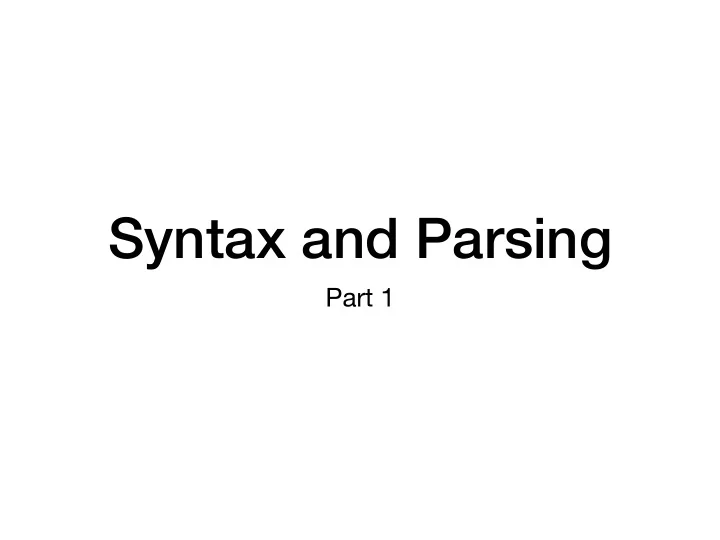

Syntax and Parsing Part 1
At this point in the course, we’re going to start to learn how PLs work under the hood
Programming languages take us from raw text on the screen to bits flipping on the processor
Languages are implemented in phases The raw text on the screen is gradually converted to a language the computer speaks
http://durofy.com/phases-of-compiler-design/
http://durofy.com/phases-of-compiler-design/ Typically called the front end
The job of the compiler / interpreter’s front end is to break down the raw text into a structure that is easier to work with programmatically This results in an intermediate representation
The job of the compiler / interpreter’s front end is to break down the raw text into a structure that is easier to work with programmatically This results in an intermediate representation Why?
The job of the compiler / interpreter’s front end is to break down the raw text into a structure that is easier to work with programmatically This results in an intermediate representation Why? Working on raw text way too kludgey!
Don’t get too hung up on specifics right now, we’ll be implementing one programming language (Forth) soon!
Today we’re going to focus on lexical analysis I.e., how do we break up raw text into a stream of tokens? Or, how do I define a token?
Next lecture we’ll talk about combining these raw tokens to build up a grammar This will help us define the syntax of a PL compositionally
Lexical Analysis Lexical analysis breaks apart a (potentially huge) file into sequence of tokens
Token : atomic piece of syntax of a language
(define (hello-world) (display “Hello, world!\n”)) LPAREN ID(“define”) LPAREN Identifier(“hello-world”) RPAREN LPAREN ID(“display”) STRING(“Hello, world\n”) RPAREN RPAREN One example of a token stream
(define (hello-world) (display “Hello, world!\n”)) Lexical analysis LPAREN ID(“define”) LPAREN Identifier(“hello-world”) RPAREN LPAREN ID(“display”) STRING(“Hello, world\n”) RPAREN RPAREN
Enter: Regular Expressions
Regular expressions are basically string matchers
A regular expression classifies strings into two categories Accept or reject
Regular expressions are a general device in computing, but there are many implementations They each vary a bit, so read the docs on whatever language you’re using
(Kris now talks about basic building blocks of regexes: constants, concat, Kleene star, union, using () for grouping) Talk about derived forms: [a-z], {a,b,c}, a+
The “language” of a regex is the set of strings it accepts
What is this language? (0|1)*
What about this one? 1(0)*
How about this one ((0|1)(0|1)(0|1))*
Write “the set of odd binary strings” as a regex
Write “an odd number of b s followed by an even number of a s”
“Any number of 1s, followed by an even number of 0s, followed by a single 1”
Regular expressions classify the so called regular languages
Recommend
More recommend